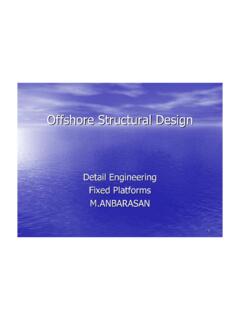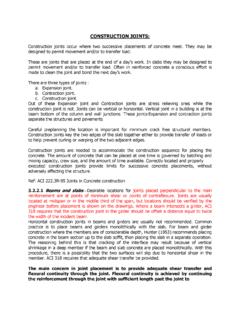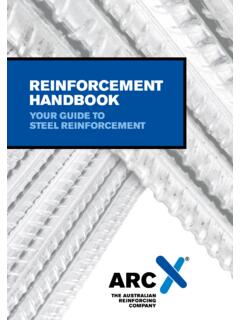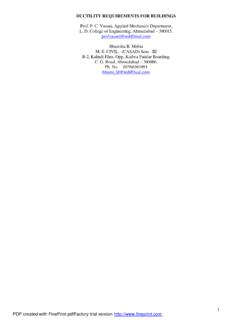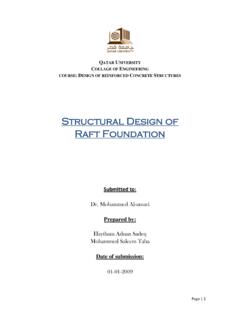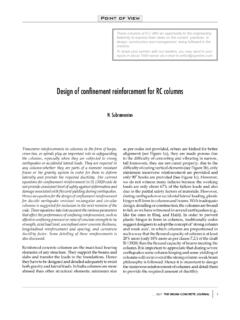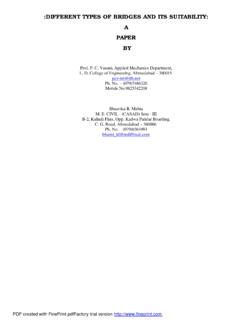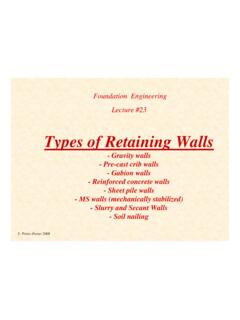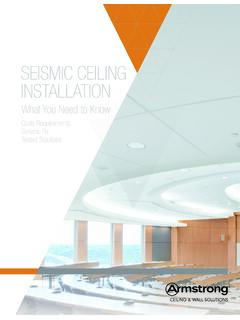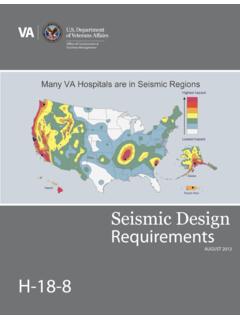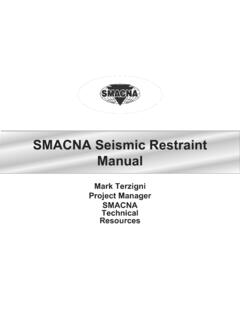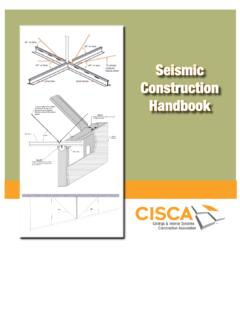Transcription of SEISMIC DESIGN AND STEEL CONNECTION DETAILING
1 2003 NASCC Proceedings Baltimore, MD April 2-5 Session D9/C27 Page 1 ABSTRACTThe SEISMIC DESIGN of connections for both STEEL momentframe and braced frame members has become much morecomplicated since the original adoption of the 1997 UBC,current adoption of IBC2000 and pending adoption ofIBC2003 in the next year of so by the various States andlocal Building Departments. Since the 1994 NorthridgeEarthquake, there have been significant changes in theAISC SEISMIC Provisions for STEEL Buildings (1997 edition,1997 Supplements #1 and #2, 2002 edition) impactingdesign of both STEEL moment frame and STEEL brace framedlateral resisting systems.
2 The results from the SAC pro-gram, initiated after the Northridge Earthquake, lead to thedevelopment of the FEMA 350 - 354 documents which arebeing extensively used for STEEL moment frame intention of this paper is to provide some practicaland useful information regarding CONNECTION DESIGN forboth STEEL moment frames and STEEL braced frames. Theemphasis is DETAILING for SEISMIC DESIGN categories (SDC)of D and higher which require Special STEEL MomentFrames (SMF) and Special Concentric Braced Frames(SCBF). DETAILING methods presented in this paper for SMFand SCBF may still be applicable to the STEEL IntermediateMoment Frame (IMF), STEEL Ordinary Moment Frame(OMF), and STEEL Ordinary Concentric Braced Frames(OCBF) in lower SDC A, B and DESIGN AND STEELCONNECTION DETAILINGM ichael L.
3 Cochranis thevice president of Brian Associates StructuralEngineers,Los Angeles,California, and a licensedstructural engineer inCalifornia. Cochran has over15 years of professionaldesign experience, havingbeen involved in the structuraldesign of both new construc-tion projects and seismicretrofit of existing buildings,with the majority of the structures being in the 1-10 storyrange. Project types include commercial, retail, multi-fam-ily residential, recreation, educational and laboratory is a past president of both the AISCP rofessional Members National Committee and the AISCP rofessional Members Committee - Los Angeles CityChapter.
4 Mr. Cochran has also been a past presenter forboth SEAOC and AISC discussing STEEL braced L. Cochran2003 NASCC Proceedings Baltimore, MD April 2-5 Sessions D9/C27 Page 2 SEISMIC DESIGN AND STEEL CONNECTION DETAILING MICHAEL Introduction: Building Codes The three typical model building codes used in the United States have now merged as a single model building code: the International Building Code, commonly referred to as the IBC. The first published code edition was the 2000 IBC which has been adopted by some states and is in the adoption review process in other states. The 2003 IBC edition is due to be published in the near future. It incorporates the changes found in the 2001 IBC and 2002 IBC Supplements that have impacts on the DESIGN of the lateral resisting systems for STEEL structures such as braced frames and moment resisting frames.
5 There is a second national building code being drafted by the National Fire Protection Agency (NFPA), which is gathering support from some governmental jurisdictions and agencies. Which model building code is selected by any individual states doesn t appear to matter much for new building DESIGN , since both model building codes reference SEISMIC DESIGN of STEEL structures to the 1997 AISC SEISMIC Provisions for Structural STEEL Buildings(Yellow Book) and Supplements. The lateral resisting systems DESIGN restrictions in both model building codes are being referenced from the ASCE-7 document on building loadings. Some states will continue to use the outdated 1997 Uniform Building Code (UBC) with some local admendments for the next couple of years.
6 The continued use of the 1997 UBC by these states is due to individual state code adoption processes and on-going political infighting between special interest groups, unrelated to structural engineering, that oppose code changes found in the family of IBC model codes. Such is the case in California which will likely continue with the 1997 UBC for another three years. Engineers doing structural STEEL SEISMIC DESIGN can reliably count on two documents as being state-of-the-art DESIGN ; the 1997 AISC SEISMIC Provisions for Structural STEEL Buildings publication, including Supplements Number 1 and Number 2, and the FEMA 350 - 354 document series for STEEL moment frame DESIGN .
7 The 2002 AISC SEISMIC Provisions for STEEL Buildings edition is due to be published shortly, and DESIGN engineers should use this most recent edition whenever possible, or portions thereof, even if not yet adopted by the state and local building jurisdictions, as long as it is not in conflict with the legally adopted building code being enforced at the time. Many building departments will allow the use of more recent DESIGN provisions, especially if it can be shown that they have been adopted for the next three year building code cycle by means of the annual building code supplements (example: 2001 and 2002 IBC supplements). If the DESIGN engineer chooses not to use the most recent state-of-the-art DESIGN information, since it has not yet been adopted by the local building department jurisdiction, the DESIGN engineer should remain aware of these DESIGN impact changes since they will likely be adopted in the next building code cycle of the IBC.
8 STEEL Moment Frames: The FEMA 350 354 publications should be used for the DESIGN of STEEL moment frame connections. The FEMA 350 documents are the result of the SAC program that was put together after the 1994 Northridge Earthquake due to the unexpected performance of STEEL moment frames. The 2002 AISC SEISMIC Provisions for Structural STEEL Buildings is not a replacement for the FEMA 350-354 documents, but should be used in conjunction with these documents. The DESIGN engineer should be aware of height restriction changes for STEEL moment frames shown in the 2002 IBC Supplement. In SEISMIC DESIGN categories (SDC) D, E, F the ordinary moment frame (OMF) is no longer permitted and the intermediate moment frame (IMF) is now restricted to 35 feet in height in SDC D, and not permitted in SDC s E and F except as allowed per the footnotes in IBC table DESIGN Coefficients and Factors For Basic SEISMIC -Force-Resisting Systems.
9 Therefore, most three story and all taller buildings will have to use SMF s in SDC s D, E, F. Both the OMF and IMF will still be permitted in SDC s A, B and C with no Height Restrictions. Single and two story buildings are a major portion of the overall building stock which is constructed each year in the United States. These buildings are often a combination of materials: concete, masonry, and wood shear walls, wood and bare STEEL deck floor and 2003 NASCC Proceedings Baltimore, MD April 2-5 Sessions D9/C27 Page 3roof diaphragms, tilt-up construction, etc. STEEL moment frames are often used in combination with some of these other lateral resisting systems or STEEL braced frames.
10 Due to the lower R values associated with these type of building systems (Bearing Wall System and Building Frame System), typically the DESIGN engineer will be looking to use either an OMF or IMF instead of SMF s. In the author s opinion, DESIGN engineers should use an IMF whenever possible instead of an OMF since the OMF is typically an untested CONNECTION . The IMF as defined in the AISC SEISMIC Provisions and the IBC is the same as the OMF in the FEMA 350 -354 documents; they both have the same beam CONNECTION rotational requirements . Due to the uncertainty regarding reliability of an untested CONNECTION , the author would not recommend using the OMF in more than a single story building in any SDC, and only if for some reason an IMF could not be used.
